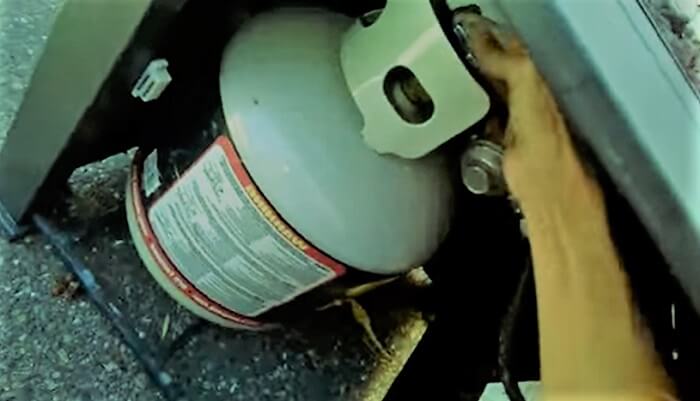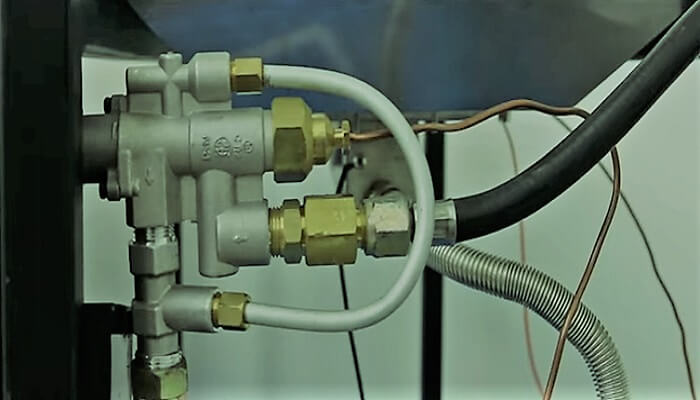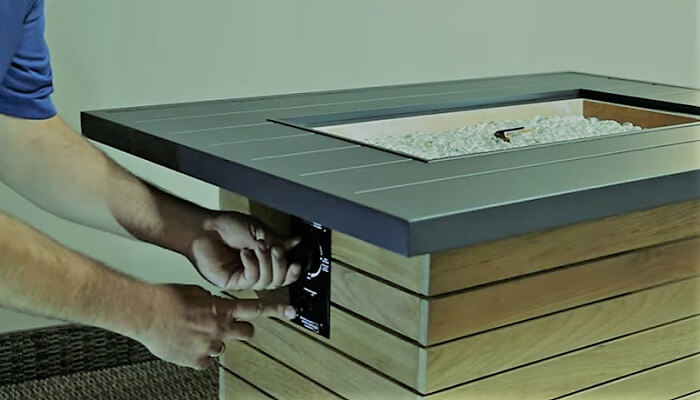Note: This article may contain affiliate links, which means if you make a purchase following our links won’t cost you extra, but we may earn a commission. Learn more
If you’ve ever had gas fire pits, you know that they can be a great addition to any outdoor space. They provide warmth and atmosphere and can be a great gathering place for friends and family.
A fire pit is not just a means of providing warmth or lighting to your home in the winter, it is an artistic ornament of your backyard, adding an extra dimension to your evening entertainment. But what if your fire pit doesn’t light up properly? What if you get a bad smell from it? Or if its spark is unfavorable, or unexpected?
If you’re angry about the fire pit problem, you’re not alone. If you can’t choose the right fire pit for you during installation or can’t maintain it properly, especially your gas fire pit, be it a propane fire pit or natural gas fire pit, you need to be prepared to face some problems.
Make sure you are using a high-quality fire pit to get the best results. Identify the problem, and fix it. If necessary, contact your local representatives and let them know why you are not happy with the gas fire pit.
Relevant Post: Best Propane Fire Pit Under $200: Top 8 Picks
1. Gas Fire Pit Not Lighting
If your gas fire pit isn’t lighting, there could be a number of reasons why. The most common gas fire pit problems are:
The gas tank is empty: This is the most common reason why a gas fire pit won’t light. Make sure to check the gas tank before troubleshooting any other issues.
Dirty or clogged burner: If the burner is dirty or clogged, it can prevent the gas from igniting. Use a brush to clean the burner, and make sure there are no obstructions.
Faulty igniter: If the igniter is faulty, it may need to be replaced.
Incorrect gas type: Make sure you are using the correct type of gas for your fire pit.
Incorrect regulator settings: The regulator controls the flow of gas to the fire pit. Make sure the regulator is set to the correct pressure.

2. Fire Pit Not Completely Light
One common problem is that the gas is not turned on all the way. Make sure that the gas valve is fully open. If it’s not, turn it until it is.
Another common problem is that the igniter is not working. The igniter is what lights the gas. If it’s not working, you won’t be able to light the fire pit. Check the igniter to see if it’s working. If it’s not, you may need to replace it.
If the gas is turned on and the igniter is working, but the fire pit still won’t light, it could be because there’s a blockage in the gas line. This is less common, but it can happen. If there’s a blockage, you’ll need to have the gas line repaired or replaced.
If the pilot light is on but there is no light, hold the knob of the gas valve for a little longer after the flame appears. If the knob of the pilot gas valve still does not have light, then there may be a problem with the thermocouple connection of the gas valve, check.
Finally, if the gas is turned on, the igniter is working, and there’s no blockage in the gas line, it could be that the gas pressure is too low. This is most common in propane fire pits. If the pressure is too low, the fire pit will not be able to stay lit. You’ll need to have the pressure checked and, if necessary, increased.
If you’re having trouble with your gas fire pit, these are some of the most common problems. By troubleshooting the problem, you should be able to figure out what’s wrong and how to fix it.
3. Black Marks
If you have a gas fire pit, you may have noticed black marks on the inside of the fire bowl. These marks are the result of incomplete combustion and can be a problem if they build up.
There are several reasons why gas fire pits can have black marks. The most common reason is that the gas is not burning hot enough. This can be caused by a number of factors, including a dirty burner, a clogged fuel line, or a problem with the gas regulator.
Another common reason for black marks is that the air intake is blocked. This can be caused by leaves or other debris blocking the air inlet, or by a problem with the venturi tube.
Finally, black marks can also be caused by the use of incorrect fuel. Using a fuel that is too high in sulfur can cause black marks to form.
If you have black marks in your gas fire pit, there are a few things you can do to clean them. The first step is to identify the cause of the problem. Once you know the cause, you can take steps to fix it.
If the black marks are caused by a dirty burner, you can clean the burner with a wire brush. Be sure to follow the manufacturer’s instructions for cleaning the burner.
If the black marks are caused by a clogged fuel line, you can clean the line with a compressed air canister. Be sure to follow the manufacturer’s instructions for cleaning the fuel line.
If the black marks are caused by a problem with the gas regulator, you can contact a gas fire pit repair service. They will be able to help you troubleshoot the problem and make the necessary repairs.
Finally, if the black marks are caused by the use of incorrect fuel, you can switch to a different fuel. Be sure to follow the manufacturer’s instructions for using the new fuel.
If you have black marks in your gas fire pit, there are a few things you can do to clean them. By identifying the cause of the problem and taking steps to fix it, you can keep your fire pit looking its best.
Related: Can You Burn Wood in a Gas Fire Pit? Why Not?
4. Put Off Soot
If you have a gas fire pit, you’ve probably noticed that it puts off the soot. While this is a common problem, there are a few things you can do to fix it.
The first thing you need to do is figure out what’s causing the soot. There are a few different things that can cause this problem, so it’s important to narrow down the possibilities.
One possibility is that your gas fire pit isn’t getting enough ventilation. If the pit is enclosed, make sure that there are vents or holes in the sides to allow air to circulate.
Another possibility is that the gas you’re using is too dirty. If you’re using propane, for example, you might need to clean or replace the tank.
You may see soot if your LP air mixer is not working properly in your fire pit installation, or if an air mixer is installed incorrectly. Check the air mixer.
If you’re using natural gas, the problem could be with the gas line. There could be a blockage or leak that’s causing the soot.
Once you’ve determined the cause of the problem, you can take steps to fix it. If the problem is with the gas, you’ll need to contact your gas company. They can help you troubleshoot the problem and get it fixed.
If the problem is with the fire pit itself, you might need to clean it or make some repairs. You can usually find instructions for doing this in the owner’s manual.
No matter what the cause of the problem is, there are a few things you can do to prevent soot in the future. Make sure that your fire pit has good ventilation, and don’t use dirty or old gas. With a little bit of care, you can keep your fire pit soot-free.
5. New Gas Fire Pit Smell
As the weather gets colder, many people love to gather around a gas fire pit to stay warm. However, sometimes these fire pits can produce a foul smell that can ruin the experience. Here are some of the most common gas fire pit problems and how to fix them.
1. One of the most common problems is that the gas fire pit is not vented properly. This can cause the gas to build up and create a strong smell. The best way to fix this problem is to make sure that the fire pit is vented properly. This can be done by opening the vents or by using a chimney cap.
2. Another problem is that the gas line is not properly installed. This can cause the gas to leak and create a strong smell. The best way to fix this problem is to have a professional install the gas line.
3. Another common problem is that the gas fire pit is not clean. This can cause the gas to build up and create a strong smell. The best way to fix this problem is to clean the fire pit regularly.
4. If your gas fire pit is not properly maintained you may get the smell. This can cause the gas to build up and create a strong smell. The best way to fix this problem is to have the fire pit serviced by a professional.
If you are having problems with your gas fire pit, it is important to contact a professional. They will be able to help you troubleshoot the problem and find a solution.
6. Gas Fire Pit Whistling
If you’re a lucky owner of a gas fire pit, you may have experienced the occasional weird whistling noise it makes when in use. Although it’s not a serious problem, it can be annoying, especially if you’re trying to enjoy a quiet evening around the fire pit with friends or family.
There are a few reasons why your gas fire pit may be whistling, and thankfully, there are also a few easy solutions.

1. One common reason for a whistling gas fire pit is that the gas is not burning evenly. This can be caused by a dirty burner, clogged vents, or a poorly designed fire pit. The solution is simple: just clean or replaces the parts that are causing the uneven burning.
2. Another reason for a whistling gas fire pit is that the flame is too high. This is usually caused by a faulty regulator or incorrect gas pressure. The solution is also simple: just adjust the gas pressure or replace the regulator. Applying a high level of pressure on a small opening can also result in a whistling sound.
3. A whistling gas fire pit can also be caused by wind blowing across the top of the pit. This is usually not a serious problem, but it can be annoying. The best solution is to build a windscreen around your fire pit to help deflect the wind.
Read More: Does a Fire Pit Need a Liner? Why or Why Not?
7. Propane Fire Pit Won’t Stay Lit
This is the most common and annoying problem. If your gas fire pit isn’t lighting, there are a few possible reasons.
1. The regulator could be set too low: If the regulator is set too low, the gas won’t flow properly and the fire pit won’t light. To fix this, turn the regulator to the “on” position and increase the gas flow until the fire pit ignites.
2. The gas tank could be empty: If the gas tank is empty, there’s nothing for the fire pit to burn. To fix this, simply refill the gas tank.
3. There could be a blockage in the gas line: If there’s a blockage in the gas line, the gas can’t flow properly and the fire pit won’t light. To fix this, check the gas line for any obstructions and clear them out if necessary.
4. The igniter could be faulty: If the igniter is faulty, it won’t be able to create a spark to ignite the gas. To fix this, replace the igniter with a new one.
5. The flame sensor could be dirty: If the flame sensor is dirty, it won’t be able to detect the flame and the fire pit will shut off. To fix this, clean the flame sensor with a brush or cloth.
6. There could be a problem with the gas valve: If there’s a problem with the gas valve, the gas won’t flow properly and the fire pit won’t light. To fix this, turn the gas valve to the “off” position and then back to the “on” position. If the problem persists, replace the gas valve.
7. The pilot light could be out: If the pilot light is out, the fire pit won’t be able to ignite. To fix this, relight the pilot light.
8. The control knob could be in the wrong position: If the control knob is in the wrong position, the gas won’t flow properly and the fire pit won’t light. To fix this, turn the control knob to the “off” position and then back to the “on” position.
9. There could be a leak in the gas line: If there’s a leak in the gas line, the gas can escape and the fire pit won’t light. To fix this, turn the gas valve to the “off” position and then check the gas line for any leaks. If there is a leak, tighten the fitting or replace the gas line.
10. The thermocouple could be faulty: If the thermocouple is faulty, it won’t be able to detect the flame and the fire pit will shut off. To fix this, replace the thermocouple.

FAQs
What Does a Thermocouple Do in a Gas Fire Pit?
The thermocouple is a safety feature that is found in gas fire pits. It is a sensor that is used to detect whether there is a flame present. If the thermocouple senses that there is no flame, it will shut off the gas supply to the fire pit.
How Do I Clean My Gas Fire Pit?
You can clean your gas fire pit by using a wire brush to remove any debris from the burner. You can also use a mild soap and water solution to clean the fire pit. Be sure to dry the fire pit completely before using it again.
How Often Should I Clean My Gas Fire Pit?
You should clean your gas fire pit at least once a week. However, if you use your fire pit frequently, you may need to clean it more often.
What Should I Do if My Gas Fire Pit Won’t Stay lit?
If your gas fire pit won’t stay lit, you may need to replace the batteries in the igniter. You may also need to clean the burner or replace the gas regulator.
My Gas Fire Pit Is Making a Popping Noise, What Does This Mean?
If your gas fire pit is making a popping noise, it could be due to a blockage in the gas line. You should contact a qualified technician to have the gas line inspected.
Can You Get Carbon Monoxide Poisoning From a Gas Fire Pit?
There is a potential for carbon monoxide poisoning when using a gas fire pit. Carbon monoxide is a colorless, odorless gas that can be produced when burning fuels such as natural gas, propane, wood, and charcoal. When inhaled, carbon monoxide can cause headaches, dizziness, confusion, nausea, and even death.
The Bottom Line
Whatever the problem, you need to make sure your fire pit works efficiently, so before you start a fire pit, you need to check to make sure it’s ready for work. You have to be careful to get better output from your fire pit.
Regularly cleaning it, checking gas adequacy, cleaning around the fire pit, and extinguishing it at the end of work is your responsibility. Otherwise, accidents can happen at any time and cause serious damage to your life and property.